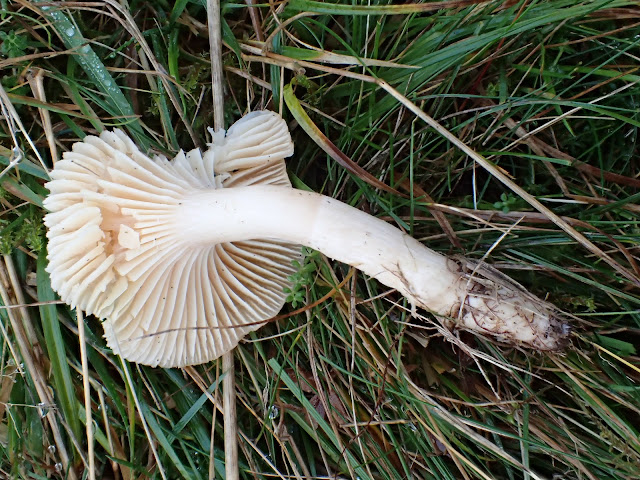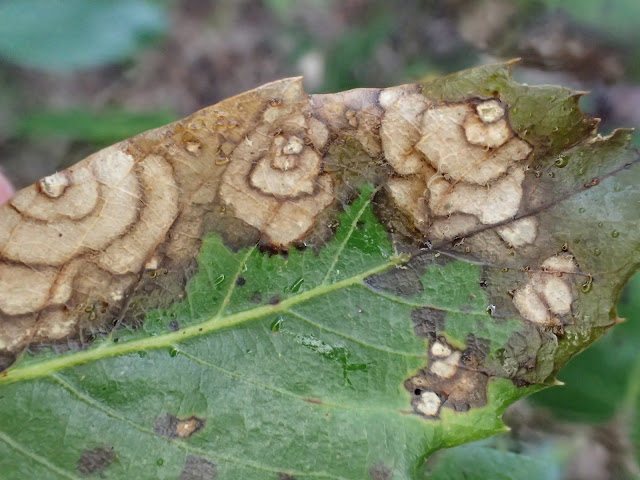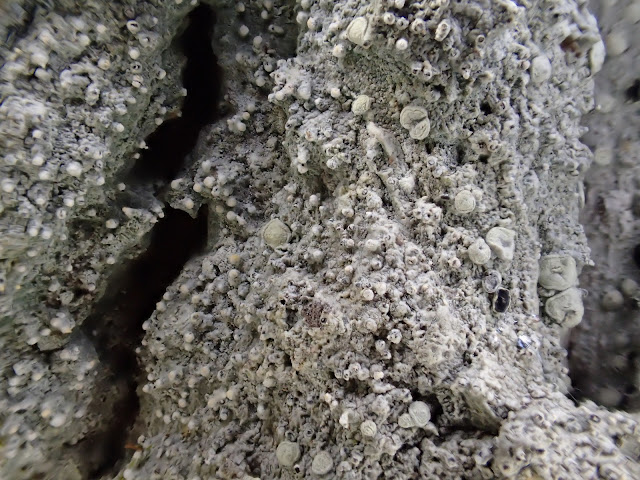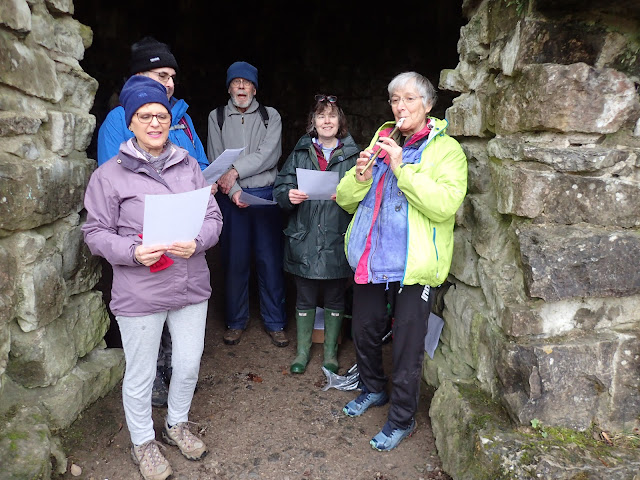An Expanded / alternative Nature Trail at Clapham to Ingleborough Cave.
Please read on if you are interested in
- Lichens
- Waxcaps (at end)
- Climate Change
- Montreal Biodiversity COP15: - And song
Countries of the world meeting to make plans about nature.
Remember 68 % of of the world's wild mammal, bird and reptile populations have gone since 1970 - Don't we have a responsibility for future generations? - Craven Conservation Group
- Clapham Nature Trail
OK, I am trying to "kill 6 birds with one stone.." and may miss all..
- the only birds I remember seeing on the walk were mallards on the lake..
and discussing whether the picture on one of the new informative notice boards may have been a purple heron rather than a grey heron -
Clapham Nature Trail "First Day of the month Climate Walk".
Each first Day of the month we have a climate walk, using prayers/notes from "Prayandfastfortheclimate.org" which are usually bang up to date since the people who write them only put them on line on the first day of the month. And have a fun walk and discover new features of our local nature.
"We" being a group from Churches Together in Settle and District and Craven Conservation Group.
Today there are six of us - eight if you included two friends we meet en route. We start at 1pm in what the weather forecast has said will be "Low cloud" - which here means "light drizzle." i.e. very grey.
At the entrance at the new "Old Saw Mill Cafe" Pete and Jules present me with a present they have picked up in Scotland
"Lichen Safari - at Dawyck Botanic Garden."
(note Dawyck is pronounced DOYK ) Dawyck Botanic Garden is a botanic garden and arboretum covering 25 hectares at Stobo on the B712, 8 miles south of Peebles in the Scottish Borders region of Scotland, OS ref. NT168352.
It is a lovely A6 booklet.
I slim through the booklet:- and point out Peltigera membranacea - a dog lichen.
"We may see that" I say
The first trees by the lake are old Holm Oak (native to the Mediterranean region) and it is covered in mosses and other epiphytes such as Common Polypody fern. . .
Could this be temperate rainforest? I have just looked at Guy Shrubsole's Lost Rainforests of Britain map, and Clapham is two miles away from the higher land which gets enough rain etc apparently to qualify for being in the "Oceanic area". The rare mosses and lichens that should be present if it was are certainly not here.. I suspect acid rain from Lancashire and Yorkshire mill towns until 60 years ago , and lack of any tree cover at all (due to sheep grazing) until the lake was dammed and woodland planted by the Farrer family makes it unlikely that they will be found. Ah well.
The leaves of the old, but planted Holm Oak are infected with something which gives this lovely pattern. It may be a fungus.
 |
| from underneath |
We see various rhododendrons that had been planted by Reginald Farrer. They are planted where the acid Ordovician rocks are at the surface next to the Craven Fault. The majority of rocks in the area are Carboniferous Limestone.
 |
| A rest on the stone seat |
The lake is an artificial lake, dammed by the Farrer Family in the past. I had forgotten how deep and steep the valley of the incoming stream is at the top end.
The trees are planted. But there are patches of woodruff, a plant that also grows in old woodland.
A medium big tree next to the path has a trunk with fissured bark with a lot of pale grey lichen down one side. I go to photograph it whilst the others patiently wait.
It has a few very dark apothecia - sort of reddish-brownish black. And lot of other pale grey lumps on it the thallus - which appear to be developing apothecia - some have a grey pruina.
 |
| Closer up |
I check once home and decide lichen is Lecanactis abietina
(I think - though I did have a shot at making it Cliostomum griffithii first)
What is the tree species?: Somehow I had thought "That's one of those pale grey crusts that grows on dry acid bark - That will be an acid tree- oak". - but I did not check.
BUT: isn't it much more likely to be ash, since ash grows much better on limestone rocks?
How DO you tell the difference between oak and ash bark?
Ah phew, - I look at the picture I can see Oak leaves on the ground it.
(And I have looked it up: Ash trees have similar sized ridges, but they have triangular shaped grooves between the ridges..)
Here on the Clapham Trail it is a new record for in SD77. This hectad is diagonally to the NW of SD86 (my own Settle hectad) where I also found the first record for this species in Cleatop Park Wood in 2020. Also on Oak, also on the SE side of the tree, and the tree sloping to the SE and SE of a footpath.
 |
| Ah - you can see the leaves. It IS oak. |
A little further north, on a stump on the left of the path, I see some Dog Lichen. In fact it is Peltigera praetextata, slightly rarer than the very common P membranacea in the Dawyck book. P praetextata has "frilly bits" on the edge of the thallus. (These lumps are called isidia and can drop off and form new bits of lichen)
We meet some friends Carole and Joseph - also out for a walk on this grey day.
We stop at the grotto, and read thoughts and prayers from the Climate sheet. We sing a hymn "O mother Earth". This was originally written for the Climate COP15 in Copenhagen in 2009, but the sentiments are good for the Nature COP15 this month in Montreal (Rather sad that none of the objectives set out in the preceeding conference at Nagoya in 2010 have been acheived)
It goes to the tune "Danny Boy". I'll print the words at the end.
Maybe next time I can record us singing it.
We descend from the woodland to the streamside that leads to the Cave entrance.
The hydraulic ram is clonking away. The stream is running past its grassy banks - where I know from previous visits there are occasional tufa like rocks. There is a white marquee outside the Clapham Visitor Cave. It is not open today - have to come back another day to see Father Christmas.
There is an ash tree next to the marquee with a lovely expanse of whitish pale grey green lichen on its trunk. I get as far as "Pertusaria" and give up.
Well, it's 10 to 3 and we had wanted to get back by 3.30. so it's time to turn round. We leave Cecile who returns by the same route, and the other five of us ascend the steep slope field to the NW of the path. (i.e. to the right in the picture above)
This is the field where on our CCG walk in 2011 we found 10 species of Waxcap and allies. .. although looking 6 weeks earlier.
We searched - and found specimens of
Scarlet Waxcap, Crimson Waxcap, Parrot Waxcap, Heath Waxcap, Meadow Waxcap, a "yellow2 waxcap, and Golden Spindles. well that is 6 plus the golden spindles
 |
| Scarlet Waxcap |
 |
| Meadow Waxcap |
 |
| Parrot Waxcap |
 |
| Heath Waxcap |
 |
| Golden Spindles |
(We also find Dung Roundhead, and Cystoderma aminathinum, and a Galerina). We have noticed no fungi in the wood on the way up (compared to about 50 in the 2011 October trip).
We meet a lady Maria gathering foliage for Christmas Decorations at the church and had a chat about Reginald Farrer and his books and writings.
At 3.50 The official time of sunset, the sun drops below the "low cloud" to give a sunset and a streak of red gold glinting into our subtle shades of grey day
On the way down on in the wood beside the road we find another species of waxcap, our first woodland species, growing under beech: Hygrophorus erubescens - Ivory Woodwax. (I say this - It is definitely a Hygrophorus .. and Ivory Woodwax was found on our 2011 list)
Down at the village, the Old Saw Mill is just closing.. so we will have to go back and visit there another day for tea.
I hope you enjoyed coming on our walk with us.
Why not come on a "First Day of the month walk with us?
1st Jan 2023 is likely to be a combined walk - maybe with the Keasden walk again - see description of our walk last year.
Then the walks in February and March will be Wednesday afternoon walks, and 1 April is a Saturday.
Or arrange a walk near where you to look at nature.
-------------
Here is the song: taken from here remember sing it to Danny Boy.
Oh mother earth,
obedient to God’s calling,
your mountain glaciers and your rivers long,
your swelling oceans, many waters falling
to thirsty lands –
for you we raise our song:
God’s precious globe, our glowing blue-green jewel
set in the bounds and mists of outer space
to be our home, our labour and renewal
where we, your men and women, find our trusted place.
Oh mother earth,
God’s joy in ever seeing
his handmaid and his ever-fertile spouse
in whom he birthed life’s many ways of being;
the birds and beasts
in you, our living house.
We know the inspiration of your beauty,
we mine the riches of your million years,
we have explored, but failed in our duty
to care for you, your other children and our peers.
Oh mother earth,
to Montreal we’re taking
our final and our deepest hope of all:
to live within our means, no more delaying;
Gone are the days
when men could steal and stall.
Now look ahead, you delegates of nations,
and see our children, what their lives are worth –
to live at last in knowing we’re relations,
Christ’s family and offspring of our mother earth.
Audrey Theodosia Bryant (1927-2015)
* Original words : “we take to Copenhagen” have been replaced by “to Montreal we’re taking”















No comments:
Post a Comment